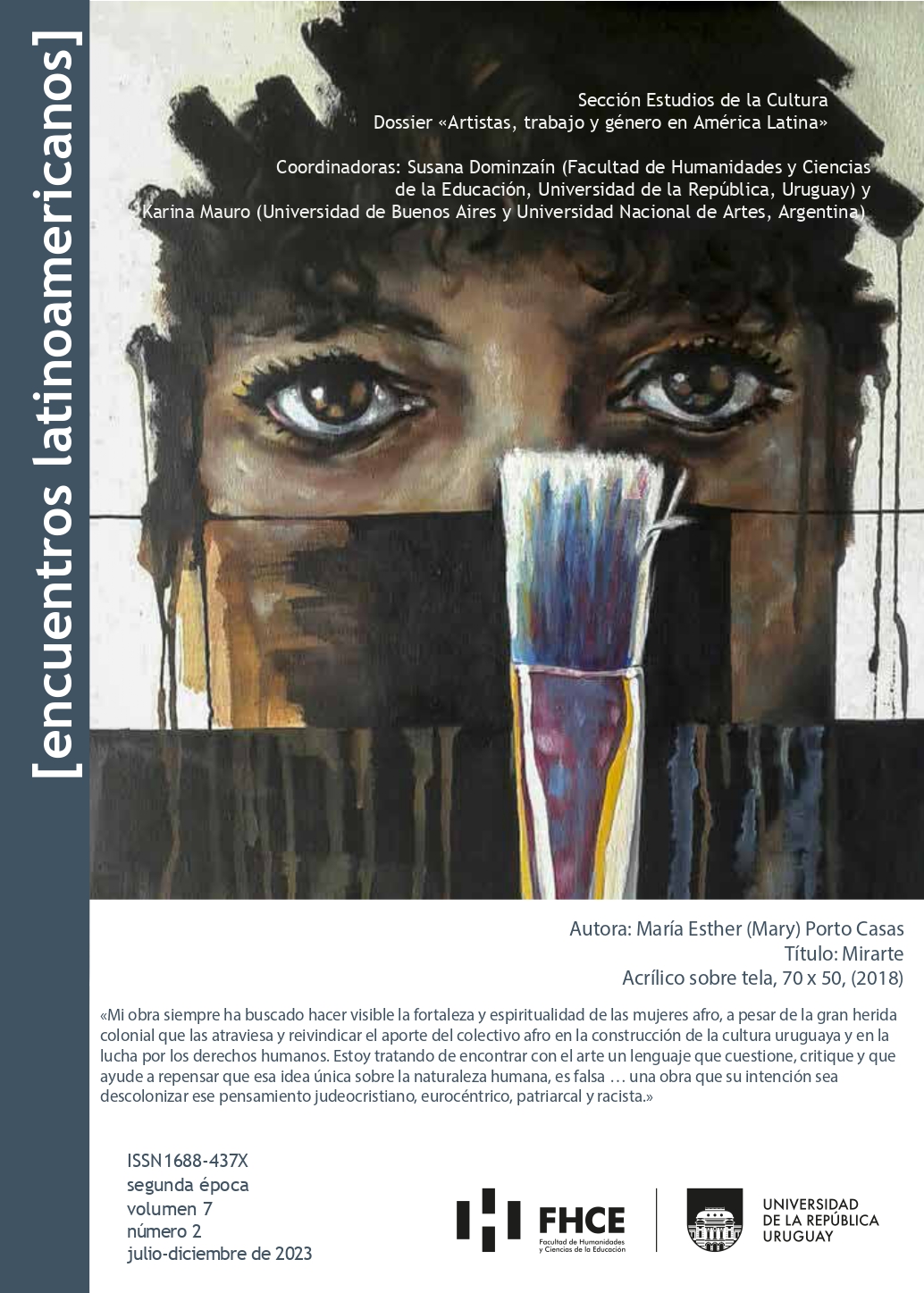Published 2023-12-28
Keywords
- Frida Kahlo,
- cyborg,
- cuerpo,
- América Latina,,
- biopoder
- Frida Kahlo,
- cyborg,
- body,
- Latin America,
- biopower
- Frida Kahlo,
- cyborg,
- corpo,
- América Latina,
- biopoder
How to Cite
Copyright (c) 2023 Eliana Laurino Cadenasso, Fabiana González Alzamendi, Giuliana Mardero Gastelumendi

This work is licensed under a Creative Commons Attribution-NonCommercial 4.0 International License.
Abstract
Due to the strong influence of coloniality of knowledge and the dominance of western Cartesian thought, Latin American thought has reproduced the dualisms surrounding the way in which we think about different dimensions of life: mind-body, nature-culture, natural-artificial. Nevertheless, alternatives that make the structure of dualistic thought tremble and that allow us to think about life from a different place have been proposed. It is in relation to the latter that we reflect about the life-work of Frida Kahlo, an artist who embodied and captured the conditions of her time in her art: the Mexican
Revolution and the militancy of the Latin American left in which she participates, characterised by a strong patriotism. Additionally, she explores the diseases and ailments that she goes through, and the multiple surgeries and rehabilitation procedures she has to undergo, hence the disabled
body acquires a leading role in her works. The aim of this essay is to question how the artist plays with the representations of the body, taking Donna Haraway’s idea of the cyborg as a starting point. Throughout her work, Frida is and represents bodies that escape hegemony, that transgress and
are formed in the ruptures of the binary oppositions of the colonial, patriarchal and western. In this way, Frida Kahlo’s life-work exhibits the microphysics of power as well, shedding light on the instability of the invented limits of technological reason as sovereign of the body and proposing new
ways of experiencing existence.
Downloads
References
- Brena, V. (2022). La madre (negra de la) patria. Raza, género y nación en una fiesta tradicional. Horizontes Antropológicos, 28(63), 71-103. https://doi.org/10.1590/S0104-71832022000200003
- Douglas, M. (1973). Pureza y Peligro. Un análisis de los conceptos de contaminación y tabú. Madrid: Siglo Veintiuno.
- Estévez, A. (2018). Biopolítica y necropolítica: ¿constitutivos u opuestos? Espiral, Estudios sobre Estado y Sociedad, 25(73), 9-43.
- https://doi.org/10.32870/espiral.v25i73.7017
- Frida Kahlo and contemporary thoughts (s. f.). Frida: a postmodern icon of the cyborg. An essay by Daniela Falini inspired by Donna Haraway’s “A Cyborg Manifesto”. http://www.fridakahlo.it/en/essays.php
- Federici, S. (2010). Calibán y la bruja. Mujeres, cuerpo y acumulación originaria. Madrid: Traficantes de Sueños.
- Fernandes Pimenta, T. (2020). Entre as palavras, o corpo e as imagens: os biografemas insólitos no enlace da obra e vida de Frida Kahlo. [Tesis de maestría, Universidade Federal de Uberlândia]. https://repositorio.ufu.br/handle/123456789/28843
- Garland Thomson, R. (2017). Extraordinary bodies: Figuring physical disability in American culture and literature. Nueva York: Columbia University Press.
- Haraway, D. (1995). Ciencia, cyborgs y mujeres. La reinvención de la naturaleza. Madrid: Cátedra
- Haraway, D. (2018a). Como una hoja: una conversación con Thyrza N. Goodeve. Madrid: Continta me Tienes.
- Haraway, D. (2018b). Manifiesto para cyborgs. Ciencia, tecnología y feminismo socialista a finales del siglo XX. Argentina: Letra Svdaca.
- Herrera, H. (2002). Frida. Una biografía de Frida Kahlo. Ciudad de México: Diana.
- Kettenmann, A. (2016). Kahlo. Colonia: Taschen.
- Lowe, S. (Ed.). (2001). El Diario de Frida Kahlo. Un íntimo autorretrato. Madrid: Debate y Círculo de Lectores.
- Martínez Barreiro, A. (2004). La construcción social del cuerpo en las sociedades contemporáneas. Papers, 73, 127-152. ttps://doi.org/10.5565/rev/papers/v73n0.1111
- Oyhantcabal, L. M. (2021). Los aportes de los feminismos decolonial y latinoamericano. Anduli, (20), 97-115. https://doi.org/10.12795/anduli.2021.i20.06
- Palaversich, D. (2008). Repensando a Frida Kahlo en el centenario de su nacimiento. Ciberletras: Revista de Crítica Literaria y de Cultura, (19). https://www.lehman.cuny.edu/ciberletras/v19/palaversich.html
- Rojas Ponce, T. (2020). Un tránsito de la sangre al plástico: lo prostético en las representaciones del deseo de maternidad de Frida Kahlo. El taco en la brea, 7(12), 264-274.
- Scheper-Hughes, N. y Lock, M. (1987). The Mindful Body: A Prolegomenon to Future Work in Medical Anthropology. Medical Anthropology Quarterly, 1(1), 6-41.

